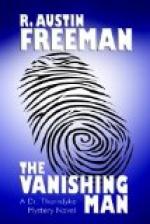THE CROWNER’S QUEST
The proceedings of that fine old institution, the coroner’s court, are apt to have their dignity impaired by the somewhat unjudicial surroundings amidst which they are conducted. The present inquiry was to be held in a long room attached to the inn, ordinarily devoted, as its various appurtenances testified, to gatherings of a more convivial character.
Hither I betook myself after a protracted lunch and a meditative pipe, and, being the first to arrive—the jury having already been sworn and conducted to the mortuary to view the remains—whiled away the time by considering the habits of the customary occupants of the room by the light of the objects contained in it. A wooden target with one or two darts sticking in it hung on the end wall and invited the Robin Hoods of the village to try their skill; a system of incised marks on the oaken table made sinister suggestions of shove-halfpenny; and a large open box, filled with white wigs, gaudily coloured robes and wooden spears, swords and regalia, crudely coated with gilded paper, obviously appertained to the puerile ceremonials of the Order of Druids.
I had exhausted the interest of these relics and had transferred my attentions to the picture gallery when the other spectators and the witnesses began to arrive. Hastily I seated myself in the only comfortable chair besides the one placed at the head of the table, presumably for the coroner; and I had hardly done so when the latter entered accompanied by the jury. Immediately after them came the sergeant, Inspector Badger, one or two plain-clothes men, and finally the divisional surgeon.
The coroner took his seat at the head of the table and opened his book, and the jury seated themselves on a couple of benches on one side of the long table. I looked with some interest at the twelve “good men and true.” They were a representative group of British tradesmen, quiet, attentive, and rather solemn; but my attention was particularly attracted by a small man with a very large head and a shock of upstanding hair whom I had diagnosed, after a glance at his intelligent but truculent countenance and the shiny knees of his trousers, as the village cobbler. He sat between the broad-shouldered foreman, who looked like a blacksmith, and a dogged, red-faced man whose general aspect of prosperous greasiness suggested the calling of a butcher.
“The inquiry, gentlemen,” the coroner commenced, “upon which we are now entering concerns itself with two questions. The first is that of identity: Who was this person whose body we have just viewed? The second is, How, when, and by what means did he come by his death? We will take the identity first and begin with the circumstances under which the body was discovered.”
Here the cobbler stood up and raised an excessively dirty hand.
“I rise, Mr. Chairman,” said he, “to a point of order.” The other jurymen looked at him curiously and some of them, I regret to say, grinned. “You have referred, sir,” he continued, “to the body which we have just viewed. I wish to point out that we have not viewed a body: we have viewed a collection of bones.”




